Neura Automata is an art installation residing in the TechMed Centre. One of the largest projects we have ever worked on, the artwork took time, skill, a large team and unwavering ambition to come to life. In this blog post I’ll share parts of its story.
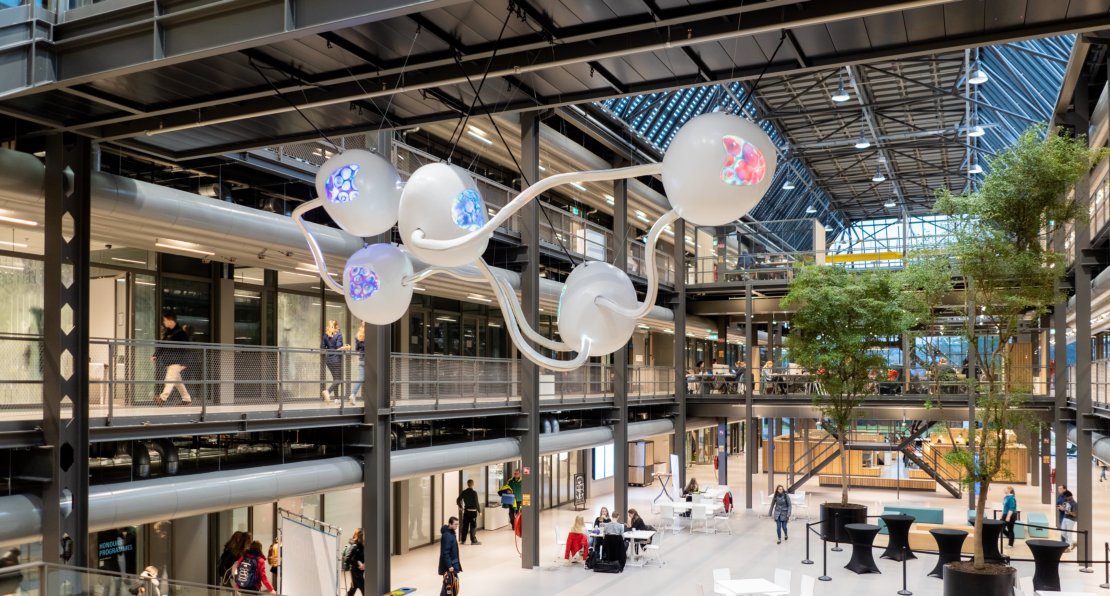
In early 2018, Remke Burrie approached DesignLab and explained that they were renovating the Technohal into what would be called the TechMed Centre. They asked if we could help produce some kind of Eyecatcher to hang in the main atrium. When we heard about the request, we enthusiastically said yes!
There were three main phases: Conceptualization, Prototyping, and Realization. We started with conceptualization in February 2018. As a starting point, we wanted to find out what the new plans with the building were and the inspiration for its design language. For this we spoke to the lead architect of the building – Jef van den Putte – as well as his colleagues. At the same time, we also wanted to understand what TechMed Centre meant for the university, both as a vision and the activities that would take place under it. For this we had discussions with the assignment owner, Remke Burrie (Managing Director TechMed), the Management Team TechMed Centre, students from the SIPA work group (Sirius and Paradoks), and staff and researchers within the TechMed umbrella to gain an understanding of what the new building means to them and the type of research and activities that would take place at the new venue.
When interviewing various stakeholders, there was a recurrent theme of the intersection of technology and biology. We felt that we wanted to capture this into something which could live in the building alongside everyone else, almost as if it and the people in the building are all part of one larger organism. At the same time, the idea that TechMed Centre is such a large umbrella where people from different disciplines work together and build on each other’s work in the pursuit of healthcare innovation, led us to work with the concept of neura (plural for neuron) and connections.
At the end of the Conceptualization phase, we landed on a single concept on paper. To figure out how we could build it, we isolated several variables in terms of materials and electronics and made prototypes of them. Later on, we tried to combine these components into a bigger picture. Like any design project, the process was chaotic. Although we had an original vision, our testing led to variations of it and we tried to embrace the unexpected. Sometimes it is not about bringing the vision to life, but letting the vision shape a life of its own way through iterative development and input from the whole team. In a way the artwork belongs to everyone.
The team started with 6 DreamTeam students and ended up with a team of 15+ students (both DT and non-DT) who have been a part of the process in some way. We also had our mentor Edwin Dertien (assistant professor UT and involved in previous art projects on campus) and safety mentor Wout Zweers (wowlab and also involved in a previous art project on campus) provide input. Wout’s role was crucial as the eyecatcher was meant to be installed for a long period of time. This meant it had to function but remain visually relevant for many years, while keeping to safety standards as it was hung right above the main staircase in the center of the building.
We produced the artwork, for the most part, in-house at the UT. This provided a monumental challenge, where we had to maximize the use of the equipment at DesignLab which also provided constraints of its own. For example, we could only use the available space in the laser cutter and adjusted the construction and files to make the most use of it. We also had to work with various departments, including the workshop facilities at the Horst building and Facilitaire Bedrijf for access to specific equipment. And not only did we have to try not to kick out or disturb our daily DesignLab visitors, we had to build it up, take it apart, transport it, and build it up again in TechMed Centre. Thankfully the TechMed Centre is next door, but even then the process was tiresome.
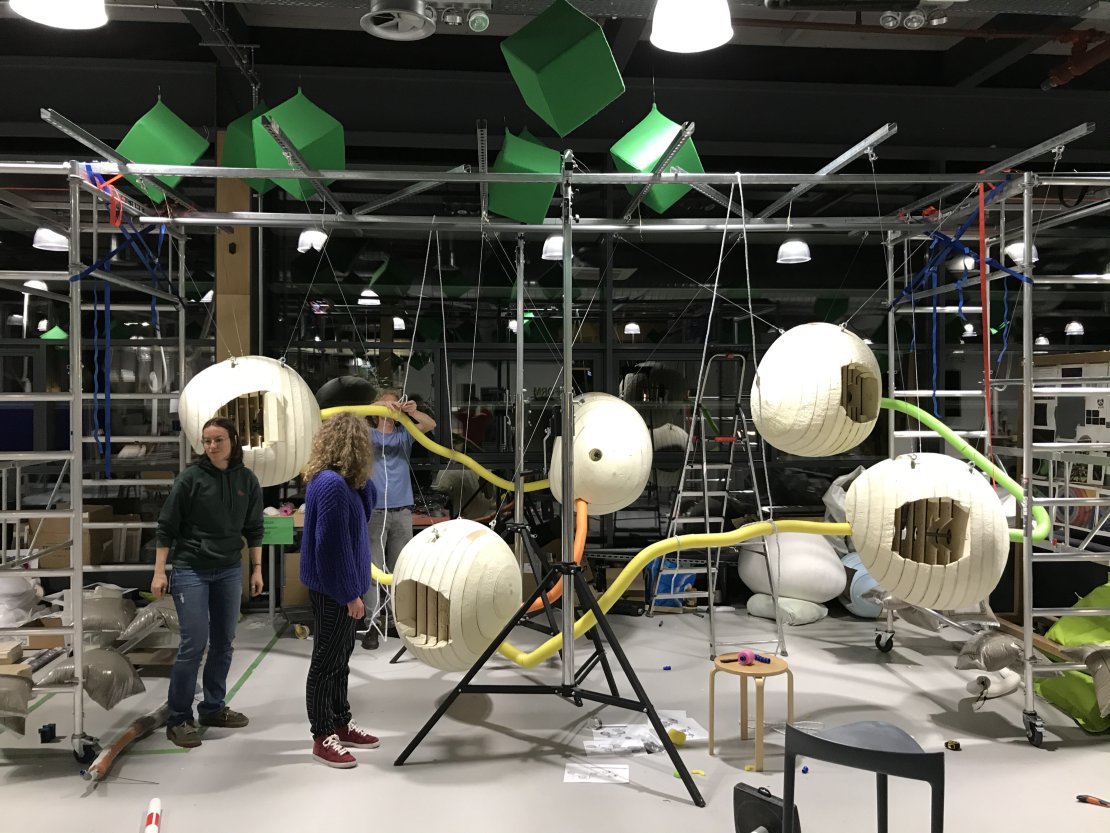
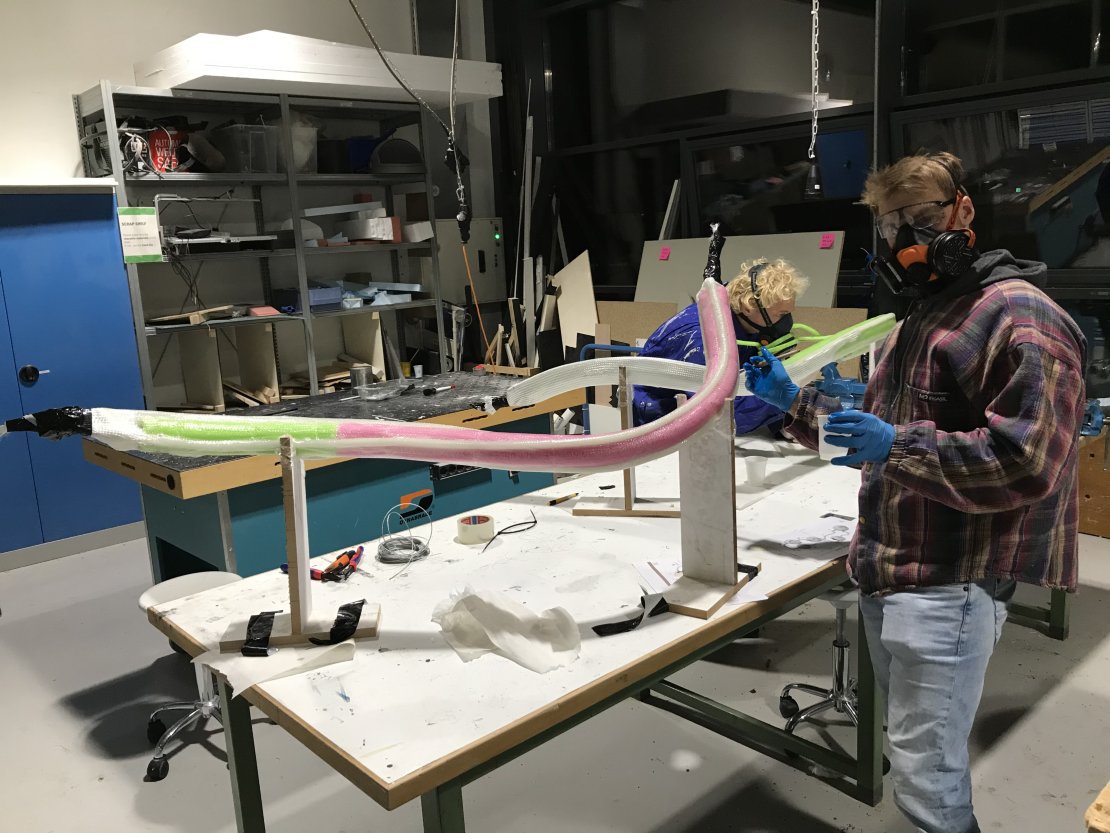
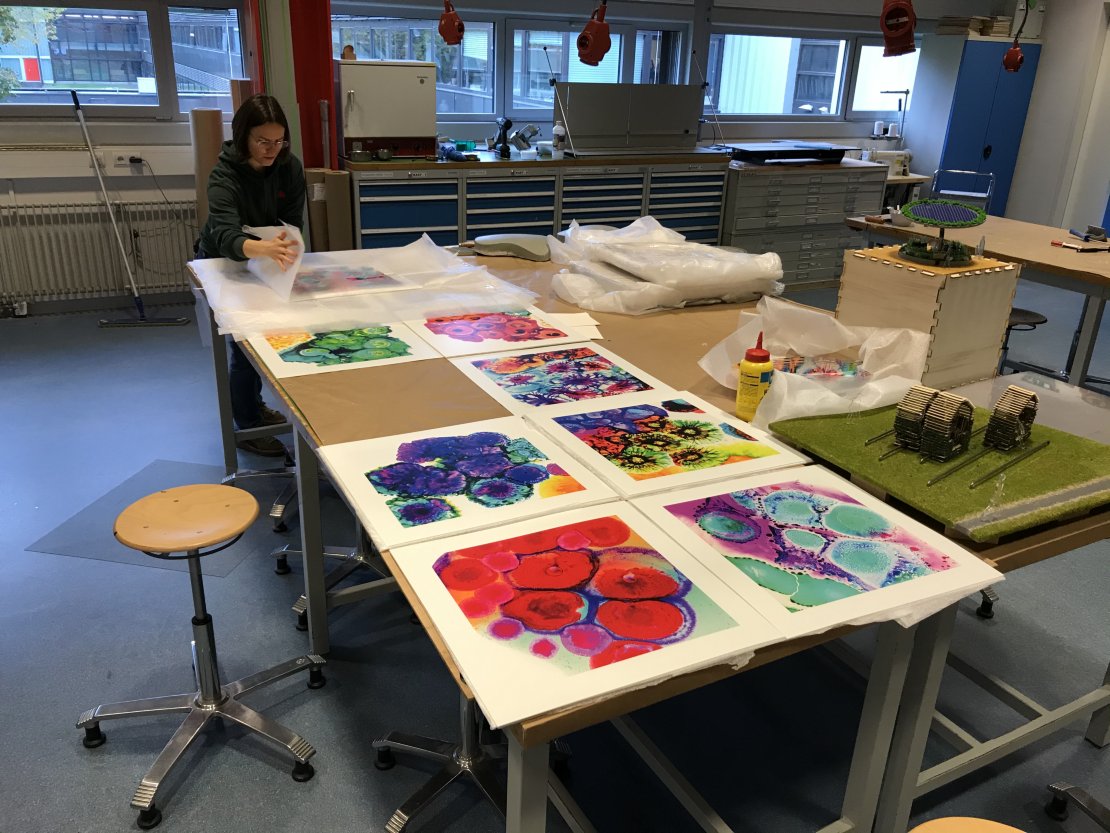
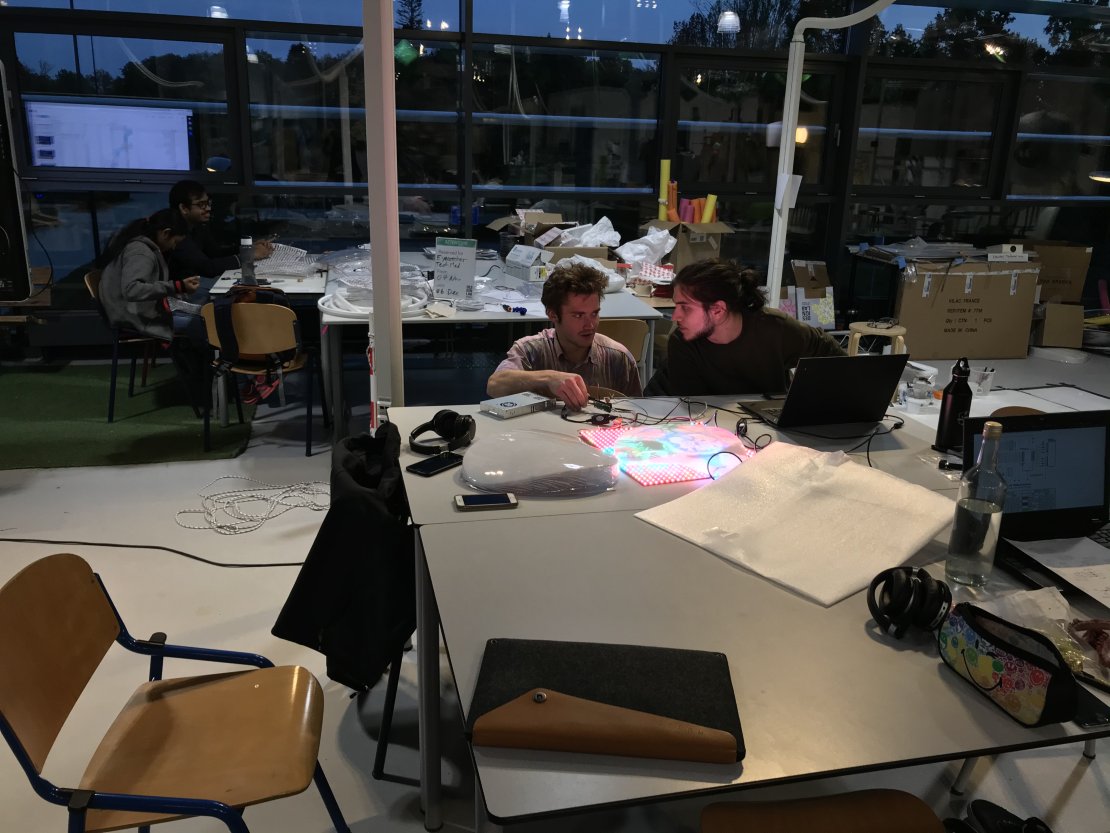
Not only that, but we also hired the folks at Dura Vermeer and Bam Bouw to help us with installing a custom-designed scaffold to place on top of the staircase so that we could install the artwork under the bridge and lead all the power cables in an organized and aesthetically consistent way. Without all the help from these parties, it simply would not have been possible. Fun fact: on the last night, at 01:00 in the morning, we had to saw off a piece of the custom-designed scaffold since the artwork was too big on one side. Don’t worry, ‘informed’ the company before doing it ;-).
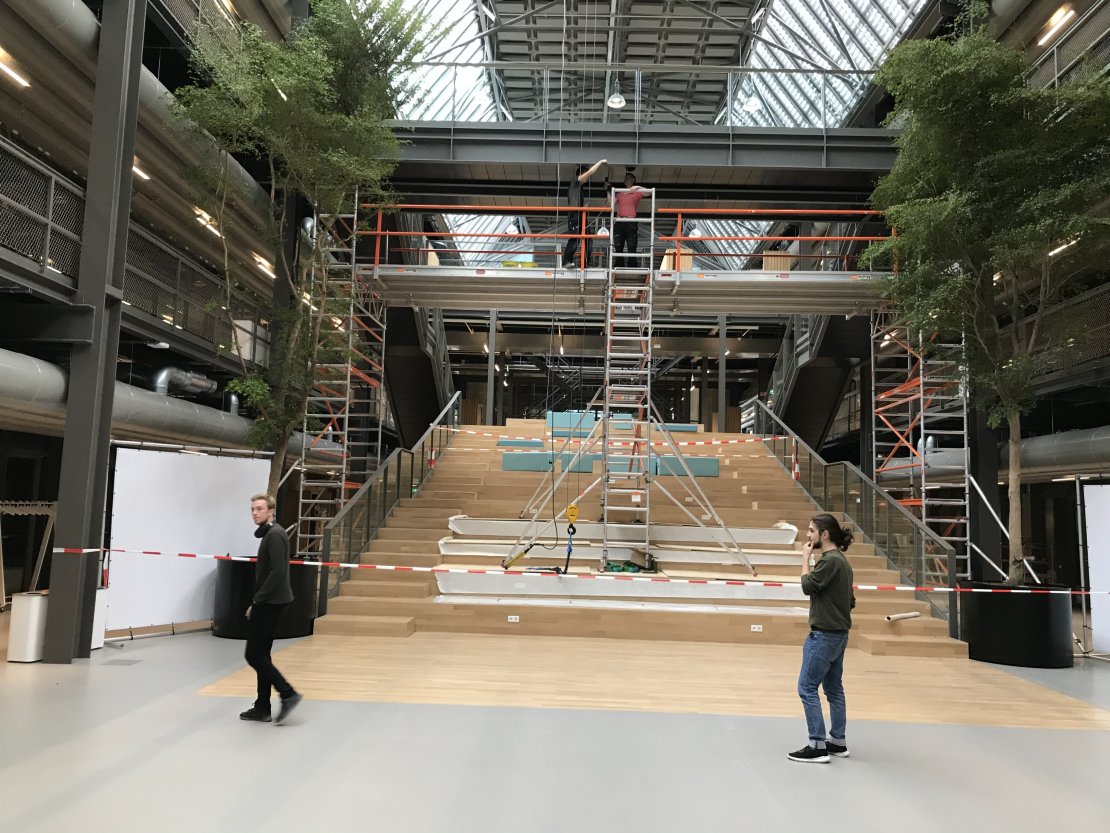
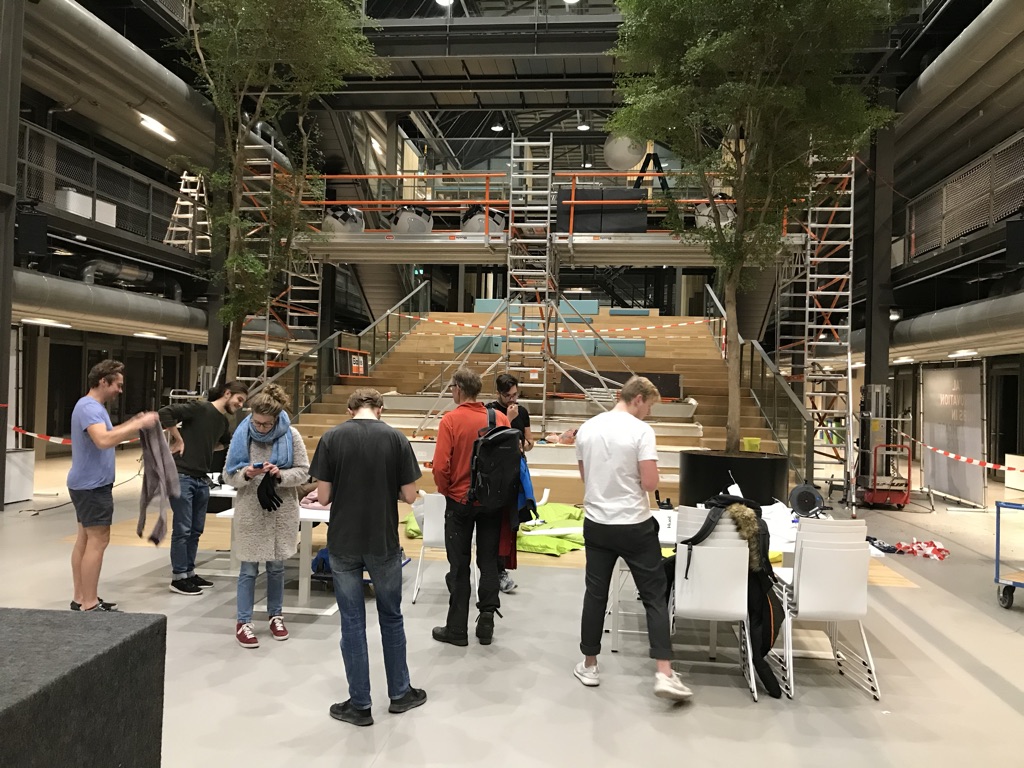
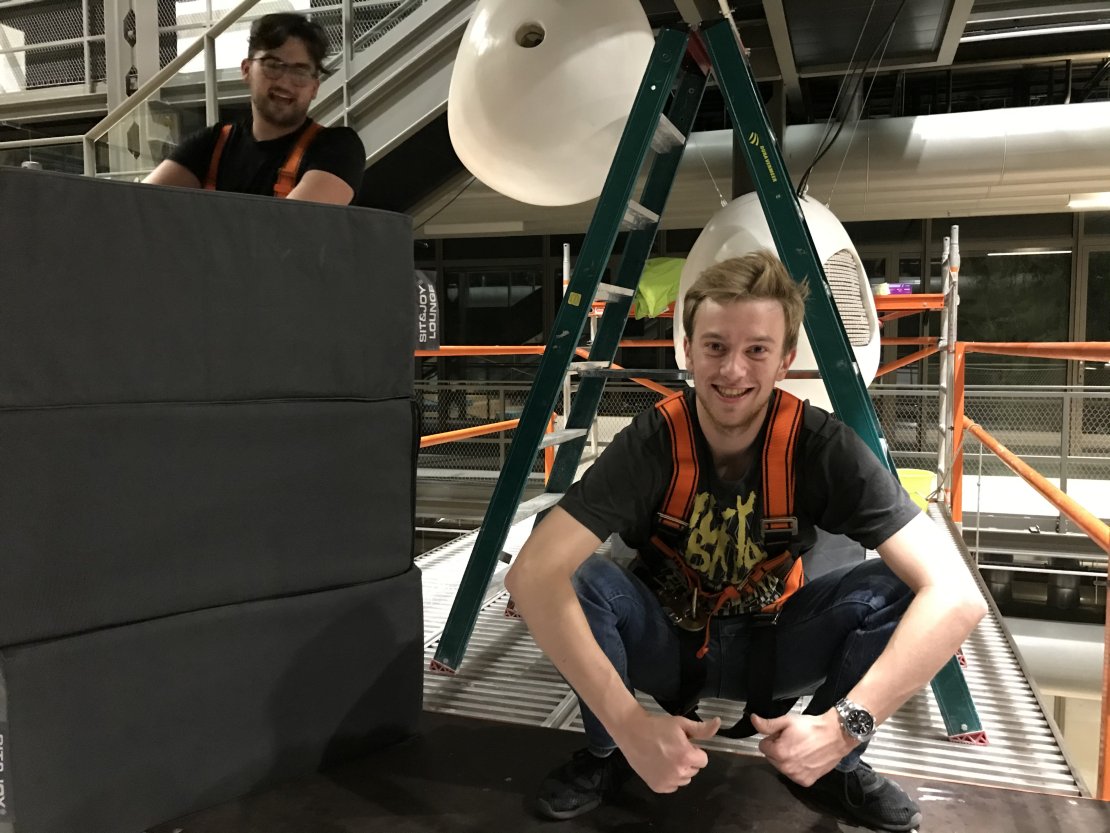
The enthusiasm and support from the DesignLab and TechMed family kept us going, despite hearing rumors here and there that we would not finish on time. Whenever we spoke with our (construction) partners at TechMed Centre, they would ask whether we would really make it on time (this is also how I learned that a rumour was spreading that we wouldn’t manage). Every time we were asked whether we would finish on time, I responded with a solid ‘yes’. It was the only thing we could tell ourselves anymore. The level of determination in the team was tremendous. In fact, some DT-ers were so busy with the eyecatcher, that we were running out of people to do shifts at DesignLab for daily business. Luckily, the whole team stepped in and some DT-ers even did multiple shifts a week. Although it was not ideal that the scale of the project was felt by others not involved, we are grateful for their support.
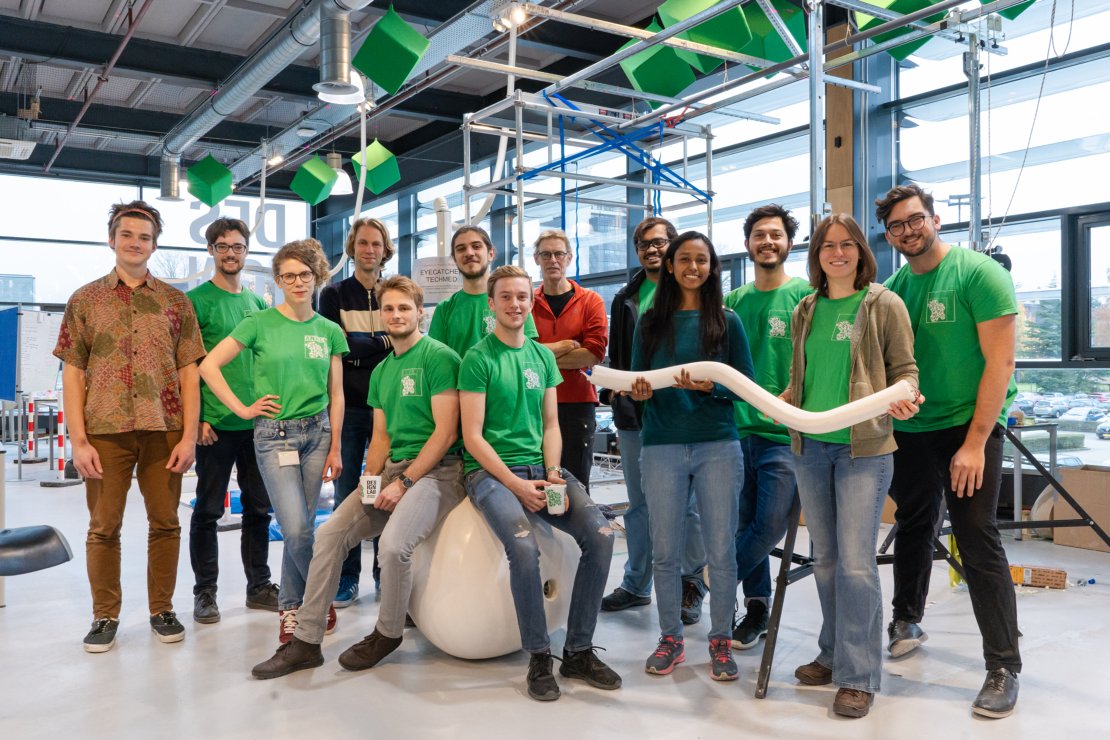
The artwork had to be done on time for the UT’s 58th Dies Natalis celebration, which would coincide with the opening of the TechMed Centre in November 2019. Because of this, we were asked to integrate the artwork within the opening celebration. I remember being told that His Majesty King Willem-Alexander of The Netherlands was in fact going to be a secret guest and would initiate the opening sequence. Unfortunately, I was also asked to keep it a secret. But because time was running short, and things began to seem impossible to finish, I felt like the team could use a bit of motivation. So I decided to share the secret with them, one by one. When the team knew, it was like they had woken up with excitement (and pressure). There was no turning back now, the artwork had to be done! We’ll never forget the moment the King turned it on. I can tell you our nerves were all over the place that day.
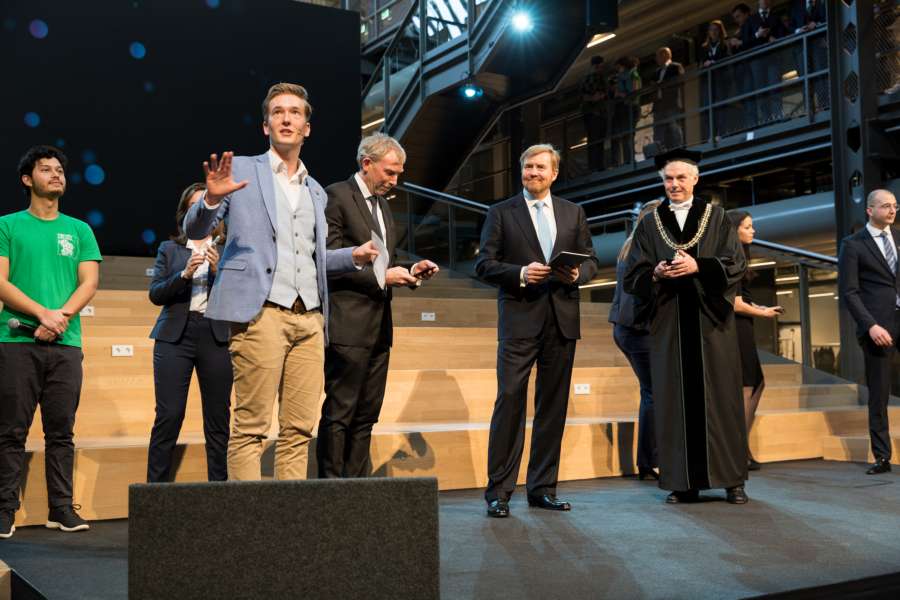
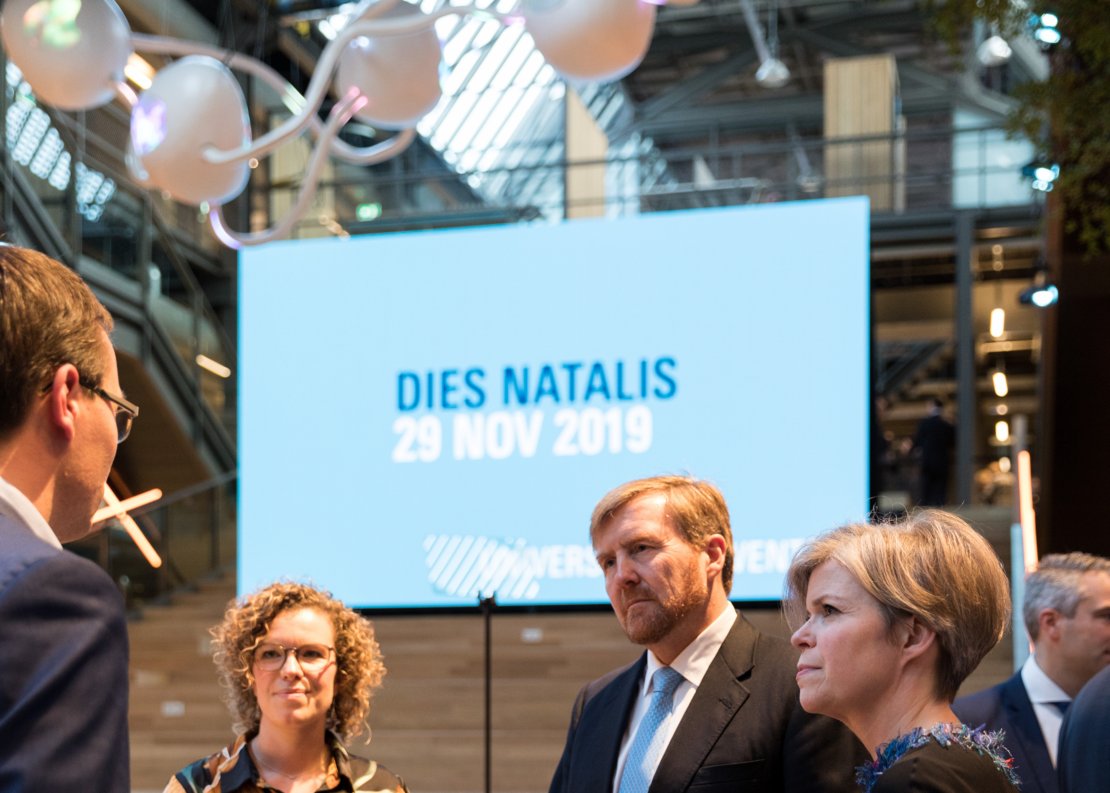
Because we started with a blank canvas completely, we encountered some creative blockades (and differences) along the way. But as a team we were able to come together and land on something we are proud of. Involving our clients in the process also helped. To produce and deliver something so large and with great care in safety and durability was also an incredible endeavor. It really tested our knowledge as students and taught us a lot about working with the ‘real-world’, forcing us to think of material properties and risks that would normally be forgotten and forgiven in prototyping projects. In this case, it didn’t just have to work, it had to work well, hang up in the middle of nowhere, and last for years. There was a lot of trial and error. Budget limitations were also a challenge, but I won’t go into that!
For many of us in the team, we were dealing with new terrain - none of us had ever worked on something so large and impactful before. We learned so much during this period, both as a group but also in our individual areas of expertise, but it took a lot of guts to dive in and believe in ourselves, despite the risks and uncertain outcome.
It was both a mental and physical challenge - in the last three months of production, we faced 12-15 hour work days even in weekends. In the last couple of days, we were barely getting any sleep and could not think of anything else besides making it on time for the Dies Natalis. We finished work at around 06:00 on Wednesday, two days before the Dies Natalis on Friday. Wednesday was also the day the scaffolding would be taken down by the construction partners that same morning. After that there would be no way to access the artwork anymore, so even fixing minor things would no longer be an option.
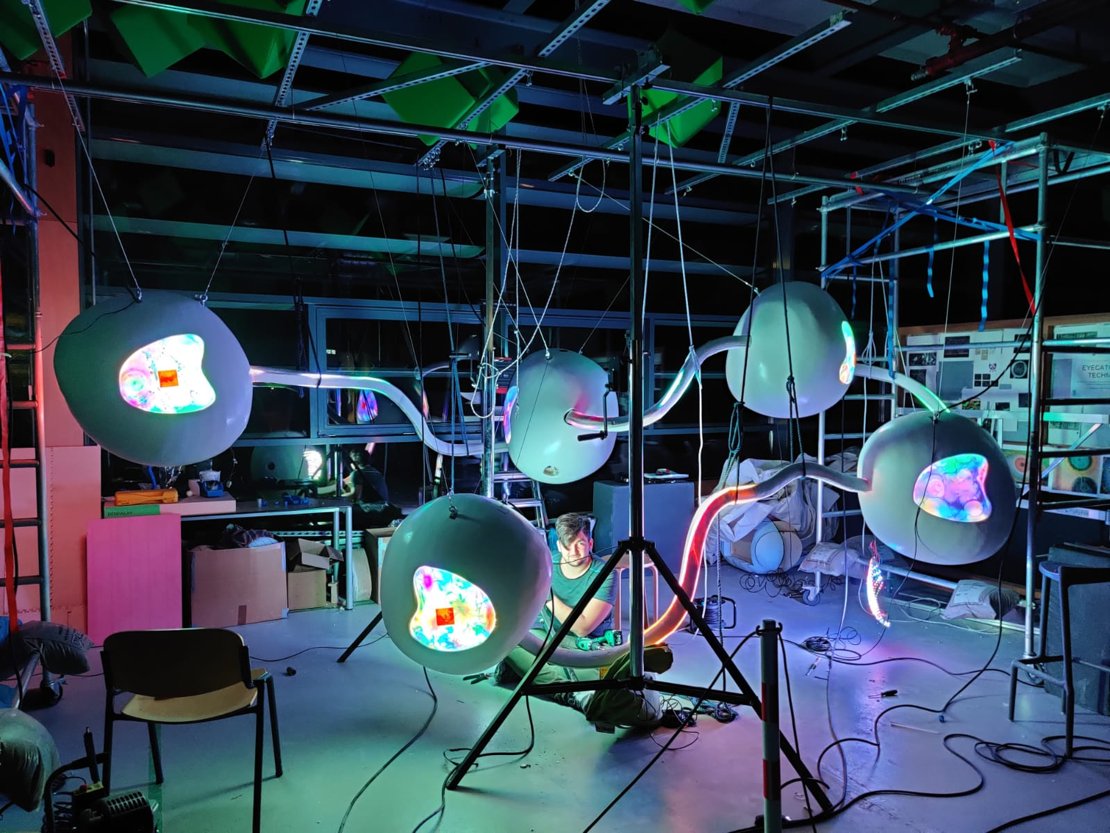
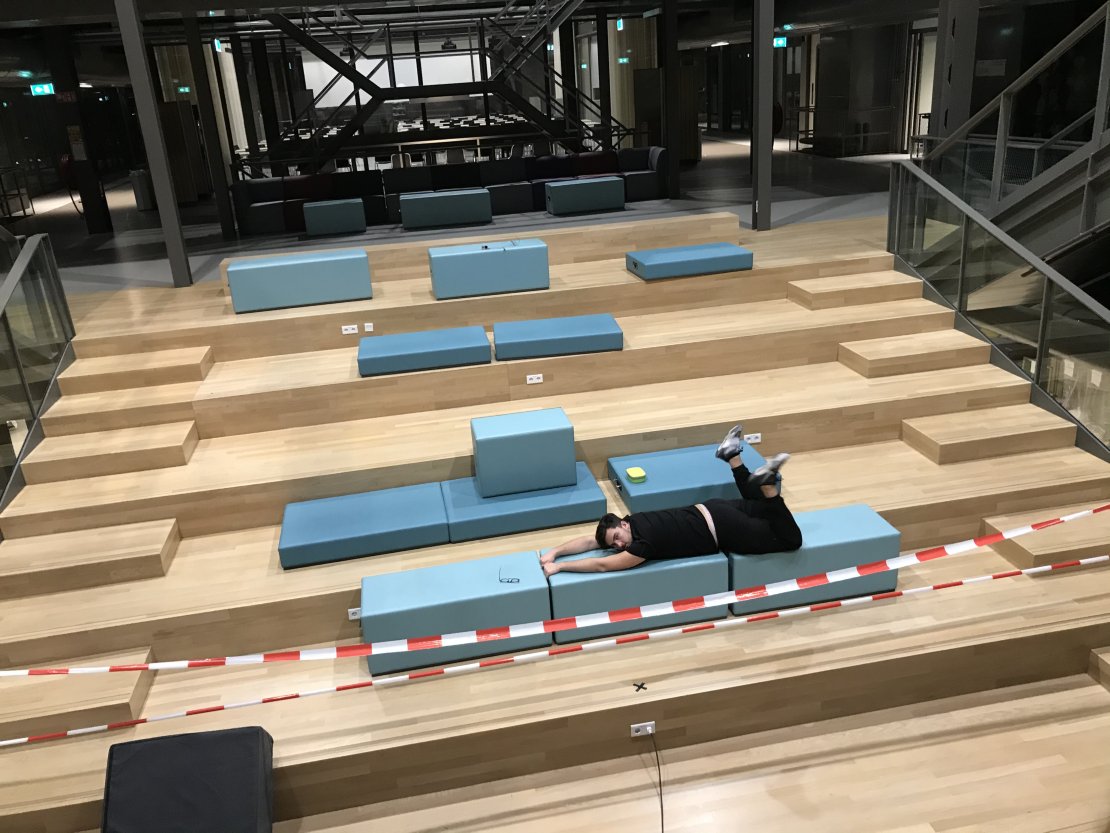
Working with the team was incredibly humbling and I couldn’t be more proud to have been a part of it, especially as this was my last major project before graduating early next year. Every time one of us walks into TechMed Centre and sees the artwork, we feel a sense of accomplishment.
I’ve heard some people refer to the installation as ‘that art thingy’. Not that I find this offensive in any way! I can understand why it might feel out of place in a building dedicated to science. But in all of scientific history, art has played a major role in breaking boundaries and shifting perspectives. Creativity enables innovation and there is art in scientific practice. I find it inspiring that our university commissioned this art project (along with many others) on campus. I think it says something about the way we are willing to look at things differently as scientists, to imagine new beginnings, to collaborate and, most of all, to welcome creativity into everything we do.
The artwork is a reflection of past, ongoing and new connections across different fields to innovate in the healthcare domain. Things are always developing, new connections made, and there is a growth that comes out of it. The artwork itself is also changing constantly - it is able to decide for itself how to light up its surface. In this way it lives alongside TechMed inhabitants. If you want to see the artwork in action, you’re welcome to pay a visit to the TechMed Centre!
Project Team DesignLab
Lyubomir Andreev
Diana Becea
Tom Bernhards
Patrick Bos
Andrei Botnariuc
Siddharth Chaturvedi
Twan Defesche
Edwin Dertien
Emiel Harmsen
Jasper-Sebastian Haesler
Annemiek Klamer
Jorik Ordelmans
Stefan Paun
Teun Schurink
Venilla Vilvanathan
Edo de Wolf
Wout Zweers (wowlab)





